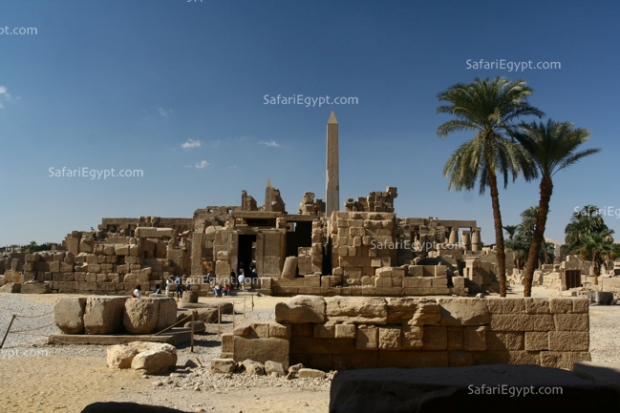|
Karnak Temple/Complex: (where history
has a special scent and taste)
Walking along an unsurpassed assembly of towering obelisks, endless
courts and splendid chapels not only reflects the magnificence of
ancient civilization, but also assures visitors that they are about
to explore the largest, most impressive temple complex ever built
by man: Karnak Complex located in Thebes (luxor).
From its modest 11th Dynasty beginnings, Pharaoh after Pharaoh added
to and changed the temple’s existing buildings as an attempt to
make their mark on Egypt’s most significant temple. The latter explains
why visitors will be amazed by the temple’s matchless combination
of many ancient generations, sensing a special historic scent and
taste worth experiencing. The temple remained buried under sand
for more than 1,000 years until excavation work began in the mid-19th
century, and continues until our present day to reveal many ancient
mysteries and secrets.

Historical Origin at a glance:
Walking along an unsurpassed assembly of towering obelisks, endless
courts and splendid chapels not only reflects the magnificence of
ancient civilization, but also assures visitors that they are about
to explore explore the largest, most impressive temple complex
ever built by man: Karnak Complex located in Thebes. From its
modest 11th Dynasty beginnings, Pharaoh after Pharaoh added to and
changed the temple’s existing buildings as an attempt to make their
mark on Egypt’s most significant temple. The latter explains why
visitors will be amazed by the temple’s matchless combination of
many ancient generations, sensing a special historic scent and taste
worth experiencing. The temple remained buried under sand for more
than 1,000 years until excavation work began in the mid-19th century,
and continues until our present day to reveal many ancient mysteries
and secrets.
Karnak Complex’s Plan:
The Temple of Karnak is actually a combination of three main temples;
that of Mut, Monto and Amun. In addition to smaller enclosed temples,
and several outer temples, stretching on 247 acres of land, and
located about three kilometers north of modern Luxor. Amun was the
King of Gods; a powerful local in the Theban deity, whose power
reached its climax after the short persecution led by Akhenaten.
This fact explains why two thirds of the property owned by the temples
belonged to Amun. During ancient times, the temple was known as
Ipet-isut, meaning "The Most Sacred of Places" due to the numerous
buildings dedicated to the God Amun.
Continue Reading about Karnak Temple (1 -
2)
next >>
|
|

